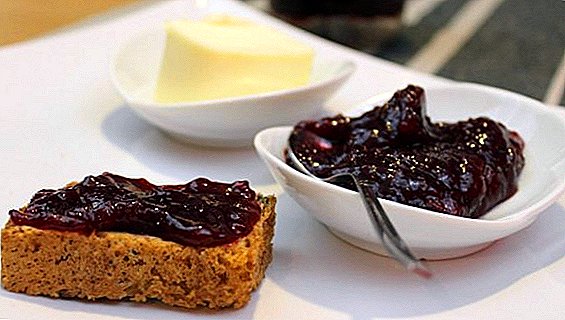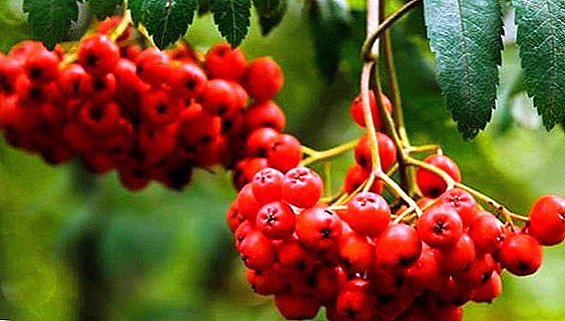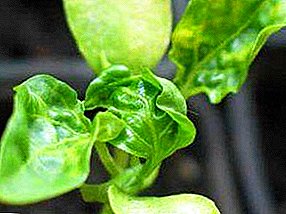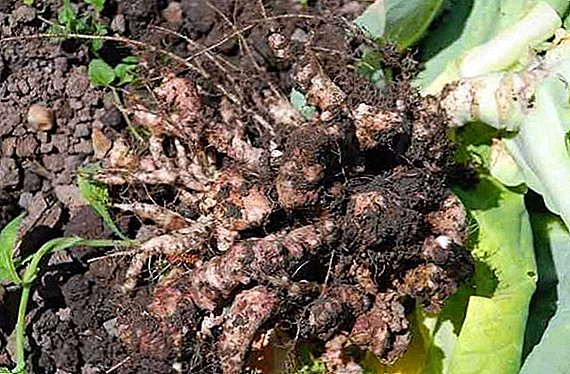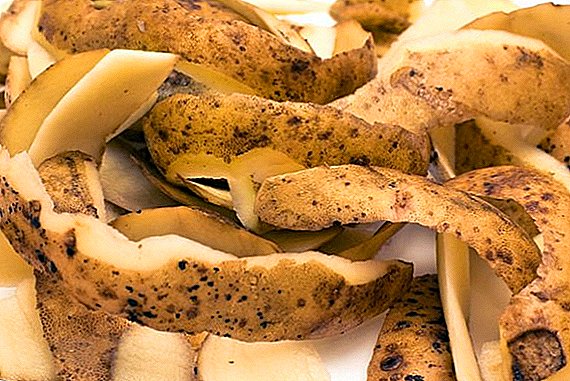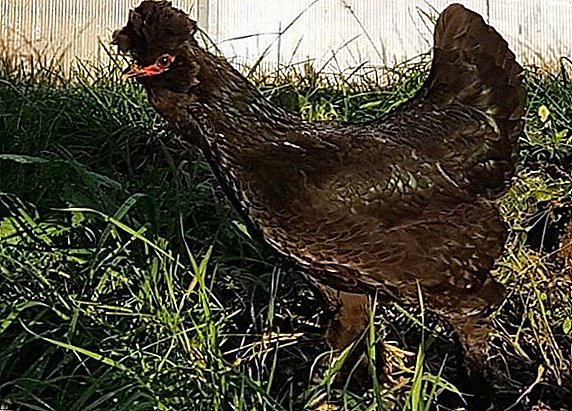 Experienced poultry farmers know how important it is to keep the temperature of the chickens.
Experienced poultry farmers know how important it is to keep the temperature of the chickens.
But among these birds there are breeds that are resistant to harsh conditions, for example, the Siberian pedigree.
We will talk about it today, discuss the advantages of the breed, its characteristics and possible disadvantages.
Breed breeding
Historical data suggests the existence of the breed in Siberia as early as the 17th century, there are documents confirming the purchase of a bird by a certain Dr. White from Boston.  There are also references to participation in exhibitions relating to 1905. With the advent of change in the political system in Russia and the subsequent civil and Great Patriotic Wars, the breed disappeared. Only in 2009, an accident helped to find the pinnacle in the village of Pavlovo. The rebirth of the breed began with the crossing of the pinnacle found and the Pavlovsky silver cock brought urgently.
There are also references to participation in exhibitions relating to 1905. With the advent of change in the political system in Russia and the subsequent civil and Great Patriotic Wars, the breed disappeared. Only in 2009, an accident helped to find the pinnacle in the village of Pavlovo. The rebirth of the breed began with the crossing of the pinnacle found and the Pavlovsky silver cock brought urgently.
Did you know? The longest flight of a chicken, recorded by the Guinness Book of Records, lasted thirteen seconds.
Description and features
Enthusiasts engaged in the restoration of the breed, note the almost complete similarity of the current specimens with the description of the Siberian pedigree of the 17th and 18th centuries, found in historical documents. 
Exterior
The first thing that attracts attention is large head with fluffy tuft over the corneous crest of both the chicken and the rooster. Comb and small earrings are red, hens are not developed. Both individuals have luxurious sideburns and a beard. The beak is short and strong, the color corresponds to the overall color of the plumage: white, black or dark gray. Grivastaya, slightly curved neck smoothly into the body.
Not large, compact body is densely covered with feathers, the back is straight and wide, convex chest. The broad, uplifted tail is slightly fanned out, the braids curl around the males. The legs are not long, densely operny, on the metatarsus also a thick short feather, tight to the body. Such shaggy and shortish legs are convenient to hide under feathers, sitting on a roost in cold weather. The breed is distinguished by its black, black-pearl and white color. It is noteworthy that there are five-fingered birds.
Chickens of breeds Paduan, Bentamka, Sybright, Gudan, Legbar, Oryol, Brekel, Russian Crested, Chinese Silk, Araukana possess decorative appearance.
Character
One of peaceful breeds. Laying ducks are tinkering in the ground, calmly accepting strangers in a flock, not fearful. Roosters, despite the desperate protection of their flocks and offspring, are generally not aggressive and are not looking for a reason to fight. 
Hatching instinct
An incubator will not be needed in the case of the Siberian peatpea: they have a well-developed maternal instinct, they will sit on their eggs patiently until all their offspring are born. Their thick plumage can warm up to a dozen eggs, and later caring mothers will diligently take up raising the brood.
Did you know? In the Guinness Book of Records came a hen from Kyrgyzstan, which laid an egg with nine yolks.
Productive qualities
The mossill is a breed of egg direction, its feature in a rather long period of productivity is up to three years.
The egg breeds include chickens leggorn, Ukrainian ushanka, Polish greenback, Oryol.
Live weight cock and chicken
Weight of adults:
- rooster - 2.7 kg;
- chicken - 1.8 kg.

Puberty, egg production and egg mass
Chickens start running at the age of six to six and a half months. The weight of eggs is from 56 to 60 g, the shell is creamy or white. In the year the hen brings up to 180 eggs.
What to feed
Layers need a regimen: feeding three times a day with a break of five to six hours between them. Required walking.
Learn more about the nutrition of laying hens: what vitamins are needed, how to prepare feed.
Adult flock
For adults, a combination of dry and wet food is needed. Purchased feed or grain available in the household can be given as dry: wheat, maize, oats, etc. Wet food is prepared from crushed grains, vegetables and fruits, greens. It is desirable that they are not too viscous, knead either on hot water or on yogurt. Every day you need to give the bird vitamins, depends on its health and productivity. Calcium supplements are required - shell rock and chalk.
Important! In a separate container, place coarse sand for layers, stuffing it into the goiter, birds grind food, facilitating the process of its digestion.
Youngsters
The first three days after the birth, chickens are given a boiled egg, up to ten days crushed grain, corn, for example. For the prevention of chickens, a couple of days are soldered with a weak solution of potassium permanganate. Then the diet is built in the same way as in adults. Food for normal growth of muscle and skeletal tissue should be balanced with all nutrients, focus on vitamins and minerals, greens. 
Conditions for content
The footgrass is resistant to low temperatures, however, the more comfortable the conditions, the greater the return from chickens. The room in which the birds will be kept should be warmed both outside and inside, close all the cracks. Gaps in the floor can be not only a source of drafts, but also a manhole for small rodents, and this is already dangerous. If the room is warmed, then there is no need for heaters in the winter, the only thing is to take the eggs so that they do not freeze.
We advise you to get acquainted with the recommendations for the manufacture and arrangement of the chicken coop with your own hands.
Birds are not large fly not high, so do not set roost too high, up to 30 cm from the floor is enough. Since the layers have fluffy plumage, sitting in the nest, they take up a lot of space. Count the number of nests based on the proportion: one nest per three individuals.
Provide a sufficient number of feeders and drinkers, birds should not crowd around them. The litter must be high and dry; moisture and dirt are the source of bacteria. In winter, laying hens can walk, about two hours on a sunny day is enough.  At the end of autumn, birds begin to moult, undergoing a process in healthy chickens without excesses. However, during this period you need to improve their nutrition, add vitamins and minerals.
At the end of autumn, birds begin to moult, undergoing a process in healthy chickens without excesses. However, during this period you need to improve their nutrition, add vitamins and minerals.
Important! Be sure to daily swimming in the ashes, due to the thick plumage of birds are prone to parasites.
Advantages and disadvantages
Among the advantages of the breed:
- unpretentiousness to the conditions of detention;
- resistance to cold and disease;
- lack of aggression in character;
- good productivity;
- longevity;
- no need for an incubator;
- high survival rate (97-99%);
- lack of nutrition.
Only flaw, which is noted by poultry farmers, is a rarity of the breed, today they are engaged in its restoration on the naked enthusiasm, it is difficult to get young stock.
Video: breed Siberian pedal stalk
To summarize: after a full recovery, when the breed gains number, it will become quite popular in many farms. She does not need frills in food, special conditions of detention, the bird has a lot of decent qualities.





